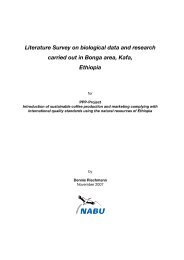Flora Biodiversity Assessment in Bonga, Boginda and Mankira Forest
Flora Biodiversity Assessment in Bonga, Boginda and Mankira Forest
Flora Biodiversity Assessment in Bonga, Boginda and Mankira Forest
You also want an ePaper? Increase the reach of your titles
YUMPU automatically turns print PDFs into web optimized ePapers that Google loves.
C. Bog<strong>in</strong>da<br />
Olyra latifolia, Poecilostachys oplismenoides <strong>and</strong> Oplismenus undulatifoliu are the only three<br />
grass species recorded <strong>in</strong> this study site.<br />
The highest recorded grass species is Oplismenus undulatifolius; 120,000.<br />
Summary<br />
The highest grass species per hectare is recorded <strong>in</strong> <strong>Bonga</strong> (nearly 500,000). With<strong>in</strong> this forest<br />
area, Tectaria cf. gemmifera is the most abundant species, 281,000. The least recorded species<br />
is Oplismenus hirtellus, 3000 (figure 12). On the <strong>Mankira</strong> forest less amounts of grass is<br />
recorded, nearly 170,000. In this forest Oplismenus undulatifolius is the highest number<br />
recorded (137,000) <strong>and</strong> accounts for more than 80 percent of the density (figure 12). Carex<br />
chlorosaccus is the least recorded species <strong>in</strong> <strong>Mankira</strong> forest.<br />
3.3.7 Agricultural L<strong>and</strong><br />
A. Trees/shrubs (<strong>Bonga</strong> only) = 20 plots<br />
3.3.7.1 Trees <strong>and</strong> shrubs recorded <strong>in</strong> agricultural l<strong>and</strong> <strong>in</strong>clude the follow<strong>in</strong>g:<br />
Eucalyptes spp, Milletia ferrug<strong>in</strong>ea, Cordia africana, Croton macrostachyus, Albizia<br />
gummifera, Papaya carica, Vepris da<strong>in</strong>elli, Coffea arabica, Sapium ellipticum,<br />
Draceana steudneri, Erythr<strong>in</strong>a brucei, Ficus ovata, Ficus sur, Maesa lanceolata,<br />
L<strong>and</strong>olphia owerensis, Euporbia abyss<strong>in</strong>ica, Celtis africana, Ehertia cymosa,<br />
Schefflera abyss<strong>in</strong>ica, Syzygium gu<strong>in</strong>eense, Clausena anisata, Enset ventricosa,<br />
Vernonia amygdal<strong>in</strong>a, Flacortia <strong>in</strong>dica, Polyscias fulva, Erythr<strong>in</strong>a abyss<strong>in</strong>ica, Ficus<br />
ovata, Ficus palmate, Trichilia dregeana, Olea welwitschii, Phonix recl<strong>in</strong>ata<br />
3.3.7.2 More than 90 trees per ha are estimated, the highest recorded be<strong>in</strong>g<br />
Eucalyptes species (12.5%). Most of this species are planted around homesteads <strong>and</strong><br />
sometimes along the roads. Next to Eucalyptes, Milletia ferrug<strong>in</strong>ea, Cordia africana,<br />
Croton macrostachyus <strong>and</strong> Albizia gummifera are kept <strong>in</strong> farml<strong>and</strong> for the different<br />
uses they give to the households. These species comprise 11.5, 9.4, 9.4 <strong>and</strong> 6.3<br />
percent of the total recorded trees. The least recorded trees (tree per ha) are Schefflera<br />
abyss<strong>in</strong>ica, Syzygium gu<strong>in</strong>eense, Clausena anisata, Enset ventricosa, Vernonia<br />
32



